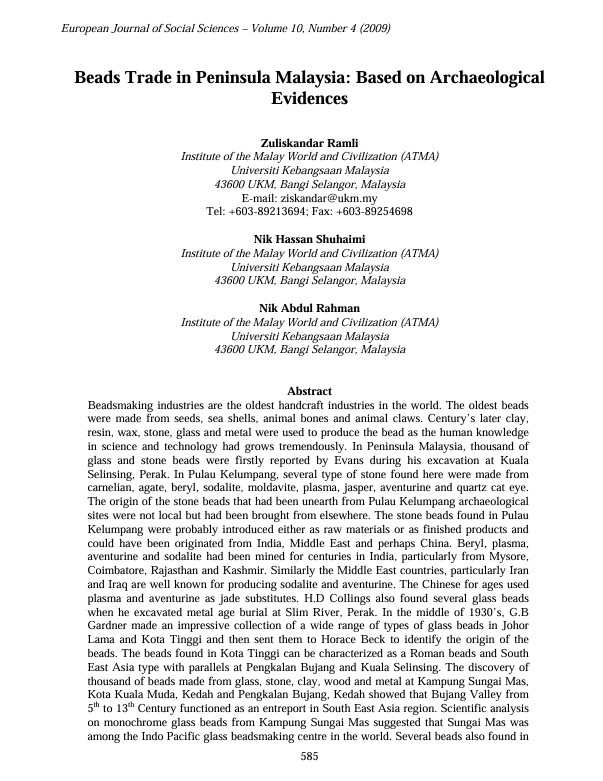|
|
|
|---|

| ชื่อผู้แต่ง | Zuliskandar Bin Ramli, Nik Hassan Shuhaimi, Nik Abdul Rahman |
| วารสาร/นิตยสาร | European Journal of Social Sciences |
| เดือน | January |
| ปี | 2009 |
| ปีที่ | 10 |
| ฉบับที่ | 4 |
| หน้าที่ | 585-593 |
| ภาษา | English |
Beadsmaking industries are the oldest handcraft industries in the world. The oldest beads were made from seeds, sea shells, animal bones, and animal claws. Centuries later clay, resin, wax, stone, glass, and metal were used to produce the bead as the human knowledge in science and technology had grown tremendously. In Peninsula Malaysia, thousands of glass and stone beads were first reported by Evans during his excavation at Kuala Selinsing, Perak. In Pulau Kelumpang, several types of stone found here were made from carnelian, agate, beryl, sodalite, moldavite, plasma, jasper, aventurine, and quartz cat eye. The origin of stone beads that had been unearthed from Pulau Kelumpang archaeological sites were not local but had been brought from elsewhere. The stone beads found in Pulau Kelumpang were probably introduced either as raw materials or as finished products and could have originated from India, the Middle East, and perhaps China. Beryl, plasma, aventurine, and sodalite had been mined for centuries in India, particularly from Mysore, Coimbatore, Rajasthan, and Kashmir. Similarly, the Middle East countries, particularly Iran and Iraq are well known for producing sodalite and aventurine. The Chinese for ages used plasma and aventurine as jade substitutes. H.D. Collings also found several glass beads when he excavated a metal-age burial at Slim River, Perak. In the middle of the 1930s, G.B Gardner made an impressive collection of a wide range of types of glass beads in Johor Lama and Kota Tinggi and then sent them to Horace Beck to identify the origin of the beads. The beads found in Kota Tinggi can be characterized as a Roman bead and Southeast Asia type with parallels at Pengkalan Bujang and Kuala Selinsing. The discovery of thousands of beads made from glass, stone, clay, wood, and metal at Kampung Sungai Mas, Kota Kuala Muda, Kedah, and Pengkalan Bujang, Kedah showed that Bujang Valley from the 5th to 13th Century functioned as an entrepot in South East Asia region. Scientific analysis of monochrome glass beads from Kampung Sungai Mas suggested that Sungai Mas was among the Indo-Pacific glass head-making centers in the world. Several beads also found in Angin Cave at Jerantut, Pahang showed that the beads were used as trading items between the coastal and inland people. The discoveries of beads have shown that international trade in Peninsula Malaysia has begun since 500 B.C. and the traders came from India, Persia, Thailand, Cambodia, Vietnam, and China.
Indo-Pacific Beads (monochrome glass beads) found in Peninsula Malaysia (Bujang Valley, Kedah, etc.)

Beadsmaking industries are the oldest handcraft industries in the world. The oldest beads were made from seeds, sea shells, animal bones, and animal claws. Centuries later clay, resin, wax, stone, glass, and metal were used to produce the bead as the human knowledge in science and technology had grown tremendously. In Peninsula Malaysia, thousands of glass and stone beads were first reported by Evans during his excavation at Kuala Selinsing, Perak. In Pulau Kelumpang, several types of stone found here were made from carnelian, agate, beryl, sodalite, moldavite, plasma, jasper, aventurine, and quartz cat eye. The origin of stone beads that had been unearthed from Pulau Kelumpang archaeological sites were not local but had been brought from elsewhere. The stone beads found in Pulau Kelumpang were probably introduced either as raw materials or as finished products and could have originated from India, the Middle East, and perhaps China. Beryl, plasma, aventurine, and sodalite had been mined for centuries in India, particularly from Mysore, Coimbatore, Rajasthan, and Kashmir. Similarly, the Middle East countries, particularly Iran and Iraq are well known for producing sodalite and aventurine. The Chinese for ages used plasma and aventurine as jade substitutes. H.D. Collings also found several glass beads when he excavated a metal-age burial at Slim River, Perak. In the middle of the 1930s, G.B Gardner made an impressive collection of a wide range of types of glass beads in Johor Lama and Kota Tinggi and then sent them to Horace Beck to identify the origin of the beads. The beads found in Kota Tinggi can be characterized as a Roman bead and Southeast Asia type with parallels at Pengkalan Bujang and Kuala Selinsing. The discovery of thousands of beads made from glass, stone, clay, wood, and metal at Kampung Sungai Mas, Kota Kuala Muda, Kedah, and Pengkalan Bujang, Kedah showed that Bujang Valley from the 5th to 13th Century functioned as an entrepot in South East Asia region. Scientific analysis of monochrome glass beads from Kampung Sungai Mas suggested that Sungai Mas was among the Indo-Pacific glass head-making centers in the world. Several beads also found in Angin Cave at Jerantut, Pahang showed that the beads were used as trading items between the coastal and inland people. The discoveries of beads have shown that international trade in Peninsula Malaysia has begun since 500 B.C. and the traders came from India, Persia, Thailand, Cambodia, Vietnam, and China.
Indo-Pacific Beads (monochrome glass beads) found in Peninsula Malaysia (Bujang Valley, Kedah, etc.)